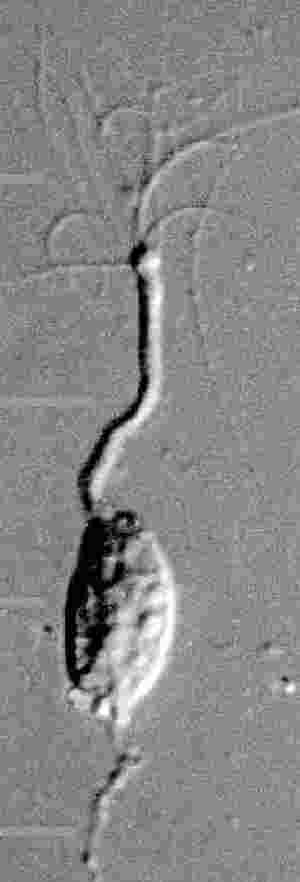Eine Doktorandenstelle ab November 2000 für 3 Jahre (BATIIa/2)
Thema: Regulation des Rezeptorstroms in Riechzellen.
Förderung durch die Deutsche Forschungsgemeinschaft im Rahmen des Schwerpunktprogramms "Molekulare Sinnesphysiologie"
Bei Stimulation mit Duftstoffen reagieren Riechzellen mit einem Rezeptorstrom, der zur elektrischen
Erregung der Zellen führt. Das Ausgangssignal der Zellen, eine Reihe von Aktionspotentialen, wird
als Riechinformation zum Gehirn geleitet (Infos zur Funktion von Riechzellen im Vorlesungsskript).
Eine besonders interessante Beobachtung ist, dass er Rezeptorstrom durch zwei unterschiedliche Arten von
Ionenkanälen fließt: cAMP-gesteuerte Kationenkanäle und Ca2+-gesteuerte Chloridkanäle. Um zu verstehen,
wie der Rezeptorstrom reguliert wird, müssen die molekularen Eigenschaften dieser beiden Kanaltypen genau
untersucht werden. Wir haben in den vergangenen Jahren vor allem an den cAMP-gesteuerten Kationenkanälen
gearbeitet (siehe Zitate unten). Jetzt gilt es, die Ca2+-gesteuerten Chloridkanäle zu erforschen, ihre
Molekularstruktur aufzuklären, ihre Regulation in der Zelle und ihren Beitrag zum Rezeptorstrom zu verstehen.
Um die Funktion der Chloridkanäle zur untersuchen, werden im Rahmen der geplanten Doktorarbeit unterschiedliche Methoden
eingesetzt:
- Mit der Patch-Clamp Technik werden die Kanäle in Riechzellen elektrophysiologisch untersucht.
- Mit molekularbiologischen Methoden sollen die Kanalgene kloniert werden.
- Immunochemische Versuche sollen zur Aufklärung von Wechselwirkungen zwischen Kanälen und anderen
Proteinen führen.
- Durch Zwei-Photonen-Imaging von intrazellulären Ionenkonzentrationen (Ca2+ und Cl-
sollen Kanalaktivierung durch Ca2+ und Chloridhaushalt der Riechzellen untersucht werden.
Diese Vielfalt von Methoden ist notwendig, um die dringensten Fragen in diesem Projekt zu bearbeiten. Wir suchen deshalb eine(n)
Dipl.-Biol., Dipl.-Chem. oder Dipl.-Phys. mit Interesse an experimenteller Arbeit und Messtechnik. Wir bieten ein hervorragendes
Arbeitsumfeld, Know-how in einem breiten Spektrum biologischer Methoden und damit die Chance, während der Promotionszeit eine
Menge zu lernen. Die Promotion kann in den Fächern Zoologie oder Biochemie an der Uni Köln durchgeführt werden.
Literatur: Bitte fordern Sie Sonderdrucke an bei s.frings@fz-juelich.de
Frings, S., Reuter, D. und Kleene, S.J. (2000) Neuronal Ca2+-activated Cl- channels - homing in on an elusive
channel species. Progress in Neurobiology 60: 247-289.
Dzeja, C., Hagen, V., Kaupp, U.B., und Frings, S. (1999) Ca2+ permeation in cyclic nucleotide-gated channels. EMBO Journal 18: 131-144.
Bönigk, W., Bradley, J., Müller, F., Sesti, F., Boekhoff, I., Ronnett, G.V., Kaupp, U.B., und Frings, S. (1999) The native
rat olfactory cyclic nucleotide-gated channel is composed of three distinct subunits. Journal of Neuroscience 19: 5332-5347.
Reuter, D., Schröder, W.H., und Frings, S. (1998) A depolarizing chloride current contributes to chemoelectrical transduction in
olfactory sensory neurons in situ. Journal of Neuroscience 18: 6623-6630.
|

